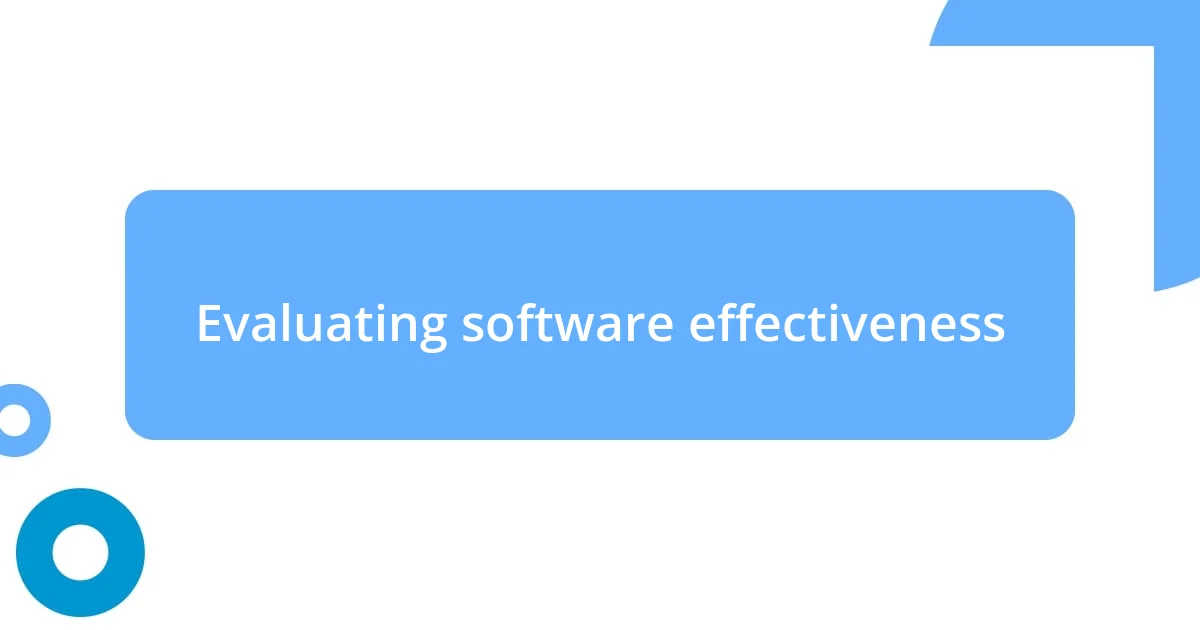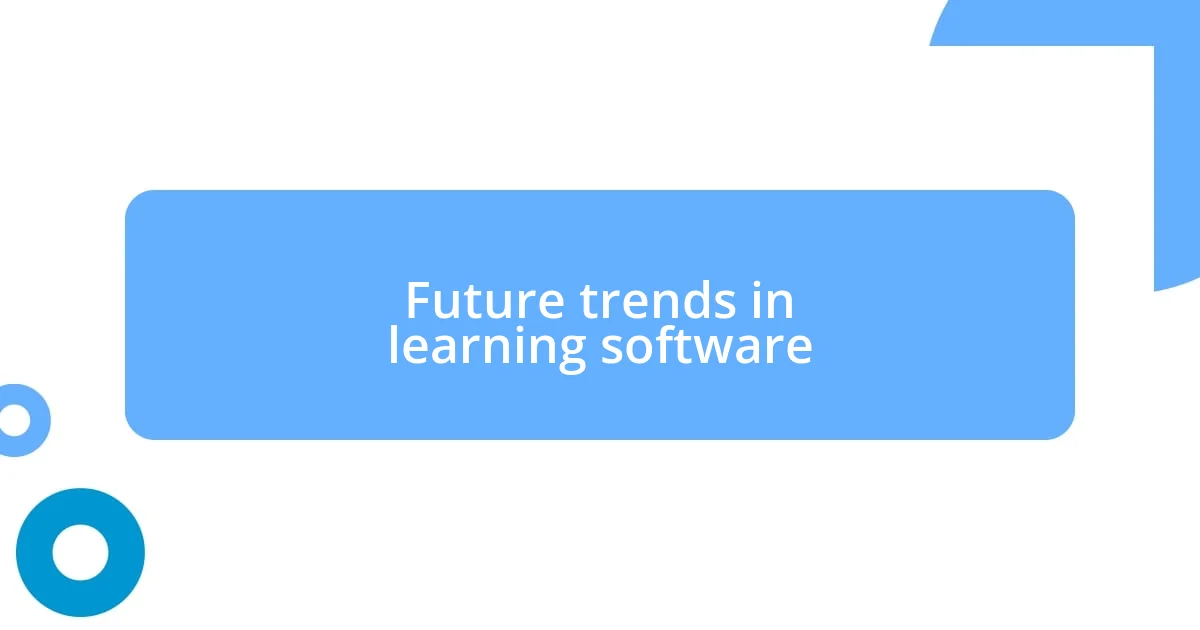Key takeaways:
- Specialized learning software personalizes the educational experience, allowing learners to engage at their own pace and receive continuous feedback, which enhances motivation and confidence.
- There are various types of specialized learning tools, including adaptive learning platforms, assistive technology, and content-specific software, each designed to cater to diverse educational needs.
- Future trends in learning software include advancements in AI, virtual/augmented reality integration, and gamification, all aimed at making learning more engaging and effective.

Understanding specialized learning software
Specialized learning software is designed to cater to diverse educational needs, making it a vital resource for many learners. I remember a time when I struggled with traditional methods of studying; the information just didn’t resonate with me. When I discovered software tailored for individual learning styles, it was like a lightbulb moment—I could finally grasp concepts that had seemed impossible before.
These tools often incorporate adaptive technologies that adjust to a student’s progress, ensuring that each learner gets the attention they need. Have you ever felt overwhelmed by the pace of a classroom? I certainly have. It was reassuring to see that with specialized learning software, I could learn at my own speed, filling in gaps in knowledge without the pressure of catching up with peers.
What’s fascinating is how these programs can track progress and provide feedback, often in real-time. Reflecting on my experience with such tracking features, I felt motivated to improve—every small milestone was celebrated, fueling my desire to continue. Isn’t it incredible how technology can turn learning into an engaging, personalized journey?

Benefits of specialized learning tools
Specialized learning tools offer considerable benefits that can transform the educational experience for learners of all levels. I vividly remember using a reading software designed for my child, who struggled with dyslexia. The immediate improvement in his confidence and ability to interact with text was incredible. These tools not only made learning more accessible but also instilled a sense of accomplishment that traditional methods often overlooked.
Here are some key benefits of specialized learning tools:
- Personalized Learning: They tailor the learning experience to individual needs, accommodating various learning styles.
- Flexible Pacing: Learners can progress at their own speed, allowing them to master concepts without pressure.
- Continuous Feedback: Instant feedback mechanisms keep learners motivated and aware of their progress.
- Engagement and Motivation: Interactive and gamified elements make lessons fun, encouraging ongoing participation and curiosity.
- Accessibility: Many tools include features for learners with disabilities, breaking down barriers to education.
Having witnessed my son flourish with the help of such software, I can confidently say that these tools are not merely technical aids; they are game-changers that can make learning a rewarding journey, rather than a daunting task.

Types of specialized learning software
When exploring types of specialized learning software, it’s essential to recognize the variety of tools tailored to specific needs. For instance, I often think about adaptive learning platforms, which adjust content and pace according to individual performance. I’d experienced a sense of relief when I found such a platform—it not only responded to my struggles but actively guided me through challenging topics, making learning feel less intimidating.
Another type worth mentioning is assistive technology software, which is particularly beneficial for students with disabilities. I can recall a moment when I supported a friend’s son, who had difficulties with attention. Introducing him to speech-to-text applications changed the way he expressed his ideas. Suddenly, he wasn’t just participating in class; he was excelling! It’s these transformative experiences that highlight the power of such tools.
Lastly, there’s content-specific software, focusing on subjects like math or reading. I remember using a math program that gamified the learning process, turning equations into entertaining challenges. It didn’t feel like work at all; instead, it sparked my competitive spirit and curiosity!
| Type of Software | Description |
|---|---|
| Adaptive Learning Platforms | Adjust content and pace based on student performance |
| Assistive Technology Software | Support students with disabilities, aiding in communication and learning |
| Content-Specific Software | Focus on particular subjects with engaging formats like games |

Key features to look for
When it comes to choosing specialized learning software, personalization is a non-negotiable feature. I vividly remember the moment my daughter found a program that adapted to her unique learning style. It was like a light bulb went off—instead of forcing her into a standard mold, the software provided lessons just right for her pace and preferences. Can you imagine the difference that makes for a child who often felt overwhelmed?
Another critical feature is engagement. I cherish the memories of watching my niece, who previously dreaded math, interact with a game-based learning platform. Her eyes would light up as she tackled each challenge; it transformed learning into an exciting quest. Engagement in software isn’t just about keeping attention; it’s about sparking curiosity. How often do we overlook the need for fun in education?
Lastly, look for ongoing assessment tools that provide real-time feedback. I recall working with a grammar app that not only pointed out errors but also offered explanations. This instant feedback helped me grasp concepts I had struggled with for years. It’s that immediate understanding that enhances learning retention—would you agree that knowing where you stand in your journey can be incredibly motivating?

Evaluating software effectiveness
When I think about evaluating software effectiveness, the metrics used to measure success often come to mind. I once used a reading app with my younger cousin, and we tracked her progress over time. The improvement in her reading fluency was so striking that it brought a smile to my face—can you imagine that kind of tangible growth?
Another facet to consider is user feedback. I remember when I was selecting a language-learning software; I dived into reviews and user experiences. One comment, in particular, resonated with me—it said, “This software has become my coach, not just a tool!” That emotional connection users develop with effective software can truly reflect its value.
Lastly, it’s crucial to assess sustainability. I’ve seen software fade from regular use simply because it became monotonous. For example, a fantastic program I tried lost its charm after a few weeks due to repetitive exercises. Have you ever felt that frustration? Identifying software that continuously engages and evolves is key to ensuring long-term success in any learning journey.

Integrating software into learning
Integrating software into learning can truly transform the educational experience. I recall my own experience with an online coding program. Initially daunting, the step-by-step approach gradually felt more like playing a game than studying. Isn’t it fascinating how something that once seemed intimidating can become enjoyable through the right software?
One of the challenges I faced was balancing traditional methods with digital tools. I remember working with a student who struggled with geography. We incorporated a virtual map exploration tool that allowed him to virtually “travel” to different countries. Suddenly, he wasn’t just memorizing facts; he was genuinely engaged and curious. How often do we forget that learning can be an adventure?
It’s also important to consider the ongoing support that integrating software provides. After starting a math tutoring platform, I was amazed at how it generated personalized quizzes based on previous performance. The consistent adjustments made a real difference in my students’ confidence levels. Wouldn’t you agree that having a tailored learning path feels more empowering, especially when faced with challenges?

Future trends in learning software
As I look ahead at future trends in specialized learning software, the rise of artificial intelligence really stands out to me. Just the other day, I read about an AI tutor that adapts in real-time to a student’s needs—imagine having a learning companion that evolves alongside you! I believe such advancements could make education more personalized and effective, transforming how we learn.
Another exciting development on the horizon is the increased integration of virtual and augmented reality. I remember the first time I used a VR headset for a history lesson—it was like stepping into the past. Can you picture how engaging it would be for students to explore ancient civilizations or conduct science experiments in a simulated environment? These immersive experiences could truly revolutionize our understanding of complex subjects.
Finally, gamification continues to emerge as a cornerstone of effective learning software. I’ve often found that when I engage in activities with a playful twist, my motivation skyrockets. Have you ever noticed how competitive elements in a learning app can spark a drive to improve? By incorporating game mechanics, educational tools can create a more dynamic atmosphere where learning feels less like a chore and more like an enjoyable challenge.














